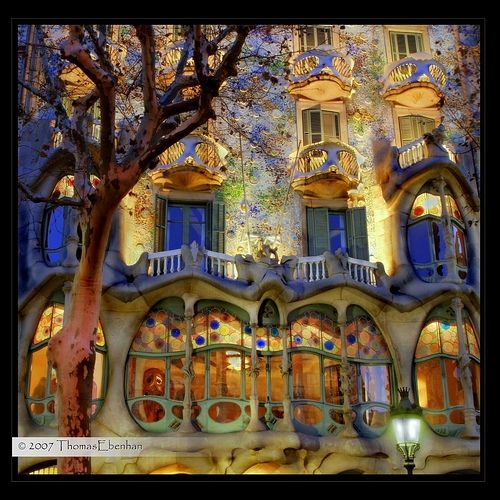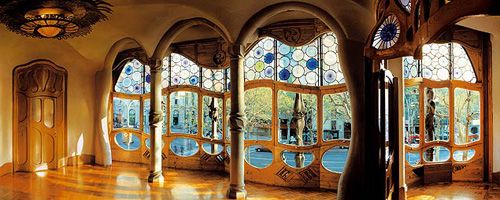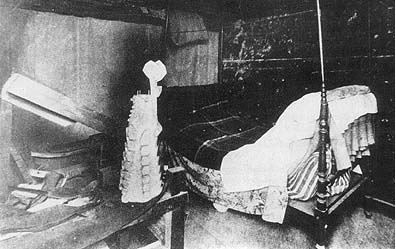Antoni Gaudí is one of the outstanding figures of Catalan culture and international architecture. He was born in Baix Camp (Reus, Riudoms), but it was in Barcelona that he studied, worked and lived with his family. It is also in the city that we find most of his work. He was first and foremost an architect, but he also designed furniture and objects and worked in town planning and landscaping, amongst other disciplines. In all those fields he developed a highly expressive language of his own and created a body of work that speaks directly to the senses.
Gaudí spent most of his professional career building the Expiatory Church of La Sagrada Família, He received the commission in late 1883 and it occupied his whole life. He did other work there, such as the Provisional Schools of La Sagrada Família (1909), and the construction of the workshop, where he worked with models and photographs, and where for his final years he went there to live to keep a closer eye on the work.
In 1910 Güell promoted an exhibition of Gaudí's work at Le Grand Palais in Paris, It had a certain international echo, which reached as far as the United States and introduced him to the architect Sullivan (Chicago School).
Antoni Gaudí i Cornet was born on 25 June 1852 and baptised the following day at the church of Sant Pere in Reus, the city where he spent his childhood. He was the son of a coppersmith from Riudoms, from whom he learned the trade, and from 1860 to 1869 he studied at the Escolapian School in Reus, where he distinguished himself in geometry and arithmetic and received a traditional religious and humanistic education. As a boy he suffered from an illness that forced him to spend long periods resting at the family home in Riudoms. He took advantage of the opportunity to observe nature, which was to be a reference point throughout his life. At that time he did a number of drawings to illustrate the manuscript magazine El Arlequín, which published ten issues of twelve copies each. In 1869 Antoni Gaudí moved to Barcelona and enrolled as a free student at the Middle School to follow the elements of physics and natural history courses. He went on to the Faculty of Sciences at the University of Barcelona and, from 1873, prepared the entrance exam for the Barcelona Province School of Architecture, at the Llotja in Barcelona, where he obtained the official architect's diploma in 1878.
He did a number of jobs for La Obrera Mataronense, the first workers cooperative company in Spain. At the same time, to pay for his studies he worked as a draughtsman for the master builder Josep Fontserè, who was landscaping Ciutadella Park at the time. He also wrote a set of notes known as El manuscrit de Reus.
From 1876 Gaudí worked as a draughtsman for his teacher Leandre Serrallach and, shortly afterwards, with the architect Francesc de Paula del Villar on sketches for the apse and the altar niche at La Mare de Déu de Montserrat, a work which began in 1887.
In 1878, with his architect's diploma, Gaudí received his first official commission from Barcelona Council, to design street lamps part of the urban equipment of the city. At the same time Eusebi Güell's father in law, Antonio López, Marquès de Comillas, commissioned him with the project for the furnishings for the family chapel and vault, near the Palau de Sobrellano, in Comillas (Cantabria).
He had more work as an architect after 1883, the time when he was working as a draughtsman and associate of the architect Joan Martorell. That was when he was commissioned with the construction of Casa Vicens, Villa El Capricho in Comillas, and the continuation of the work on Expiatory Church of La Sagrada Família was entrusted to him. Shortly afterwards he received the first major commission from Eusebi Güell(a powerful industrialist), his future patron and main customer, which gave him the building of the pavilions at the Güell Estate, followed by Palau Güell, in Carrer Nou de la Rambla.
In 1887 he began to plan the Episcopal Palace in Astorga and the following year the works on the Teresian School in Barcelona. He then built the Casa de los Botines in León and in 1892 worked on a religious building for the Franciscan friars in Tangier, the Catholic Missions of Africa, which he never completed.
One of the last works Gaudí did for the industrialist Eusebi Güell was the building of the church at Colonia Güell, in Santa Coloma de Cervelló, which he began in 1898. In the same year be built Casa Calvet, which won the Barcelona Council annual award, and in 1900 he started the works on Güell Park and the Torre de Bellesguard. At the same time he did a number of religious projects: at Montserrat the First Mystery of Glory of the monumental Rosary, and in Palma the restoration of the cathedral. In 1905 he worked in La Pobla de Lillet on the Artigas Gardens and the Xalet del Catllaràs. And in 1906, when he finished Casa Batlló, he began the building of Casa Milà. He is attributed the preliminary project for a hotel in New York, which was never done.


The expiatory church of La Sagrada Família was his greatest project which began on 19 March 1882, a project by the diocesan architect Francisco de Paula del Villar (1828-1901). At the end of 1883 Gaudí was commissioned to carry on the works, a task which he did not abandon until his death in 1926. Since then different architects have continued the work after his original idea.
The building is in the centre of Barcelona, and over the years it has become one of the most universal signs of identity of the city and the country. It is visited by millions of people every year and many more study its architectural and religious content.
It has always been an expiatory church, which means that since the outset, 131 years ago now, it has been built from donations. Gaudí himself said: "The expiatory church of La Sagrada Família is made by the people and is mirrored in them. It is a work of art that is in the hands of God and the will of the people." The building is still going on and could be finished by 2030.
When Gaudí died, the management of the works was taken over by his close associate Domènec Sugrañes, until 1938. Later directors were Francesc de Paula Quintana i Vidal, Isidre Puig i Boada and Lluís Bonet i Garí, all associates of Gaudí, people who knew the master and who directed the works until 1983. After that Francesc de Paula Cardoner i Blanch and then Jordi Bonet i Armengol became director. Since 2012 is Jordi Faulí i Oller who has occupied the post.
In 1930 the bell towers of the Nativity façade were finished and in 1933 the Faith door and the central cypress.
In July 1936, at the time of the military uprising and the outbreak of the Spanish Civil War, revolutionaries set fire to the crypt, burned the Temporary Schools of La Sagrada Família and destroyed the workshop. At that time the original plans, drawings and photographs were lost, and some of the scale plaster models were smashed. We should point out, however, that since Gaudí's intervention in 1883 and in spite of those acts of vandalism the building of the church has never stopped and has always respected the will of the architect's original design.
After the Spanish Civil War the construction of La Sagrada Família began again and the church continued to rise slowly. From 1939 to 1940, the architect Francesc de Paula Quintana i Vidal, an associate of Gaudí since 1919, restored the burnt crypt and reconstructed many of the damaged models, which were used to continue the construction according to Gaudí's original idea.
In 1952 the XXXV International Eucharistic Congress was held in Barcelona, and a number of events were organised in the church on that occasion. The same year the Nativity staircase was built and the façade illuminated for the first time; from 1964 it became permanent by decision of the Barcelona Council.
The works continued strongly in 1954, when the foundations of the Passion façade were begun, based on the many studies done by Gaudí between 1892 and 1917. After the foundations came the crypt, where in 1961 a museum was opened to explain to visitors the historical, technical, artistic and symbolic aspects of the church. On that façade the four terminations of the bell towers were erected in 1976; they were finished the following year.
One important date is 1955, when the first "collection" was made, a whole day devoted to collecting funds to pay for the works, an initiative that was maintained in the following years as a way for society to take part in the construction of the church.
On 19 March 1958, the feast of St Joseph, the sculptural group representing the Holy Family, done by Jaume Busquets, was placed on the Nativity façade.
From 1978 the foundations of the nave and the crossing were done and the columns, vaults and façades of the main nave and the transepts were erected.
In 2000 the vaults of the central nave and the transept were built and work began on the foundations of the Glory façade. That year, on the occasion of the new millennium, a mass was held inside the church which provided an opportunity to grasp the grandiosity of the work.
In 2001 the central window of the Passion façade was completed with the installation of a stained glass window dedicated to the resurrection, the work of Joan Vila-Grau. The four columns of the centre of the crossing were also finished.
The figure and work of Gaudí were especially remembered in 2002, when the Barcelona Council promoted International Gaudí Year on the occasion of the 150th anniversary of his birth. La Sagrada Família took part with different events, such as the restoration, removal and opening of the Sagrada Família Temporary Schools as a new exhibition space, or the "Night of Light and Fire", a show held on 1 June which, with its special illumination and a spectacular castle of fireworks, was the highlight of the commemoration.
Sagrada Familia 1910
Gaudí sought out stimulus for his creations in medieval books, in the gothic art that was then experiencing a renaissance, in illustrations of oriental structures and in the organic shapes of nature. The straight line, rigidity and order in forms was broken with the arrival of Arte Nouveau at the beginning of the Nineteenth Century.
Gaudí was not insensitive to this change, and developed a style of his own. The theoretical writings of Englishman John Ruskin, who in 1853 taught that ornament was the origin of architecture, greatly influenced him. He was also significantly influenced, at a younger age, by Viollet-le-Duc's book on medieval French architecture from the eleventh to the sixteenth centuries, and by books by other authors, such as William Morris.
Gaudí had a bad temper (there is a Catalan saying: "Gent de camp, gent de lamp," which means "People from the country are quick-tempered people"). He said that his bad temper was the one thing he was never able to control in his life. On the other hand, Gaudí took interest in the social problems of the workers, and felt attached to the people. His blonde hair, deep blue eyes, fine features and rosy skin made him appear Nordic, but he always retorted to whomever told him so, showing his pride for being Mediterranean.
Turn-of-the-century Barcelona flourished, thanks to the textile industry; the wealthy liked to be surrounded by artists, intellectuals and famous people, and the bourgeoisie enjoyed great prestige. This was a good atmosphere for the young architect, who saw how numerous doors were opened for him to carry out his projects. Anyway, Gaudí never renounced contact with the less-favored working classes from which he came. It is not surprising that his first large project was workers' housing in a factory, the Cooperativa Mataronense ("Mataró Cooperative"). The project was intended to improve the workers' quality of life, but Gaudí's project was ahead of its time (which was more conservative), and only one section of the factory and a kiosk were built. The architect was slightly disappointed, but the presentation of his project at the Paris World Fair in 1878 meant the beginning of his fame. It appears that Gaudí achieved his greatest fame and renown in 1910, gaining the attention of some Americans who asked him to build a hotel in New York. An exhibition on Gaudí's work, promoted by Eusebi Güell, was held in the Grand Palais in Paris, from April to June of 1910, and some of the plans and photographs exhibited there were also taken a year later to the I Salón de Arquitectura (First Annual Architecture Show) in Madrid. In 1911, he had Maltese fever, and stayed for a time in Puigcerda, where his condition worsened and, believing his time had come, he made out his will.

Gaudi's bed in his studio next to the Sagrada familia
To the day of his death, he worked exclusively on the Sagrada Família, and in 1925 moved his residence to the studio he had on the premises. In his old age, Gaudí was a man that was conformed with little and dressed without much care; so much so that the day of his accident nobody recognized him as he lay on the ground. On June 7, 1926, he was run over by a tram at the intersection of Carrer de Bailén and the Gran Vía, and the taxi drivers refused to take a poor vagabond to the hospital (the municipal police fined them later for not assisting an injured man). He did not seek out contact with journalists and he avoided cameras, so there are few photographs of the architect. This change in attitude may have been caused by a series of events that took place beginning in 1912. That year, his niece, Rosa Egea, who lived with him in Barcelona, died. In 1914, his faithful collaborator, Francesc Berenguer Mestres, died, and for matters of professional fees, he was confronted with the Milà family in litigation. In 1915, the continuity of the construction of the Sagrada Familia was endangered by a serious economic crisis. En 1914, construction of the Colonia Güell was definitively interrupted. Two years later, his friend, Doctor Torras i Bages, Archbishop of Vic, died. In 1918, his best friend and patron, Eusebi Güell, passed away.
They were sad events that affected him but did not limit his energy and desire to see his greatest work, the Sagrada Família, come into being. Gaudí died at the age of 74 (June 12, 1926), but if it hadn't been for the tram he may have lived many more years, since his father had lived to the age of 93, with all his vigor. Half of Barcelona dressed in black to give final homage to a man that had become very popular, although few had ever met him personally. His body was buried in the crypt of the edifice where he had worked for the last 43 years of his life, the Sagrada Familia.
.jpg)
Gaudi's Studio